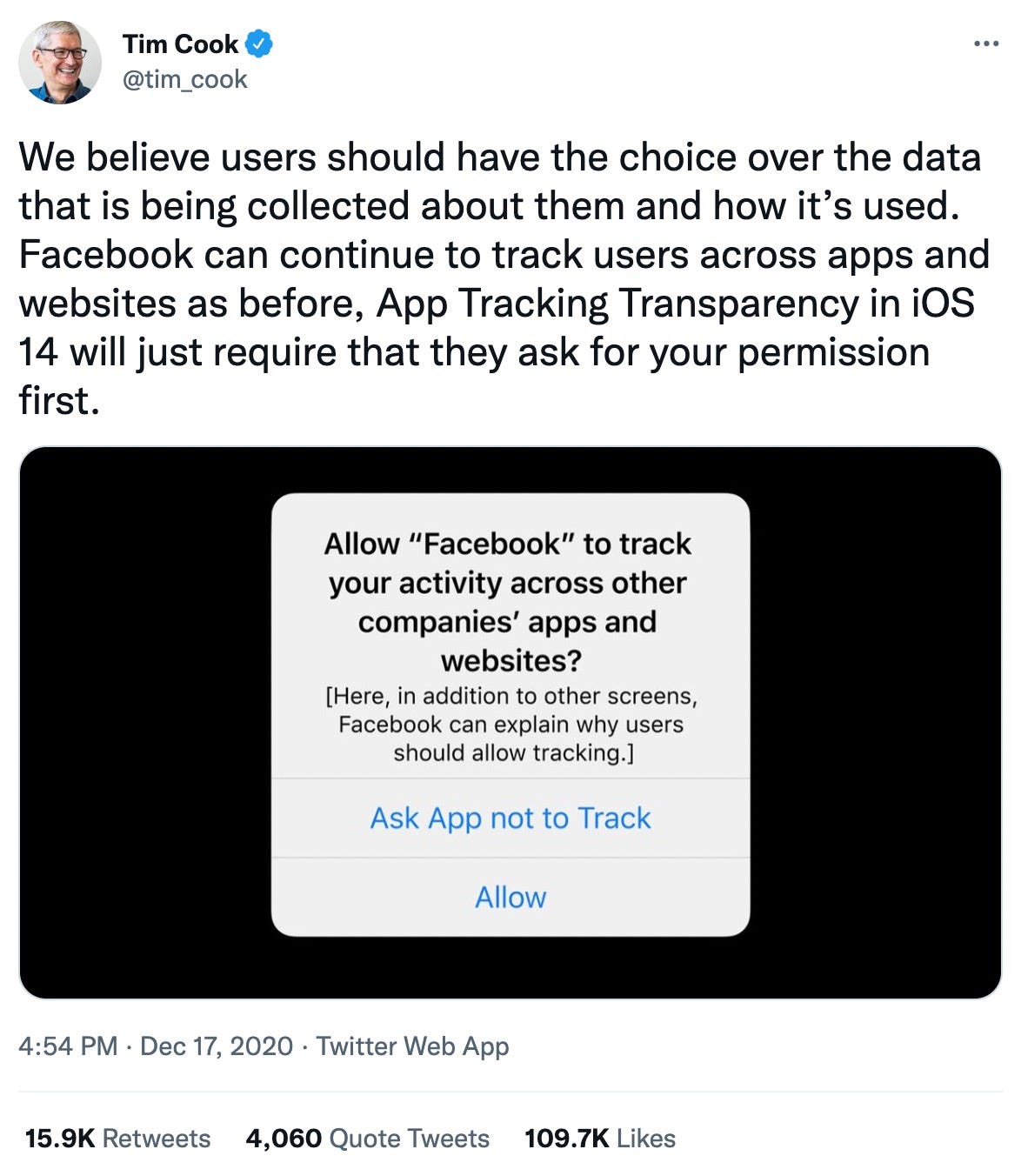
This article will explain why Eddie Svirsky and I are launching Fueled, a customer data platform designed specifically for eCommerce.
Our passion for this work might feel odd. Why do these guys feel so strongly that the world needs another Customer Data Platform? Or the more basic question: What the heck is a Customer Data Platform?
To answer these questions, we have to explain the great threat currently facing product and brand creation:
Tim Cook vs. Mark Zuckerberg. 🥊🥊
Since the dawn of time (the mid-2000s), social media has been abuzz about consumer privacy with respect to digital ad targeting. About two years ago, Tim Cook announced that Apple would be enforcing consumer privacy, particularly with respect to Facebook advertising, with the release of iOS 14.
 (https://twitter.com/tim_cook/status/1339720611313065984)
(https://twitter.com/tim_cook/status/1339720611313065984)
This move was hailed by many well-intentioned advocates for consumer privacy. Of course Facebook should be required to ask its visitors for explicit permission to track them across apps and websites, right?
Ethically, the answer is “yes.” Full stop. Transparency, choice, and stewardship of personal data matter.
Where it gets sticky, however, is the position in which this puts small businesses and emerging eCommerce brands, which depend upon Facebook advertising to reach consumers at a reasonable customer acquisition cost.
Say what you will about poorly-targeted (or annoyingly well-targeted…) online ads — access to affordable, effective, self-service online advertising has allowed for incredible innovation and entrepreneurship in DTC eCommerce.
Yes, Facebook and Google have made trillions on the backs of these brand builders and creators. But hundreds of thousands of incredible emerging businesses have benefited from this arrangement too.
And, let’s face it. The genie won’t be put back in the bottle.
There’s no scenario where emerging-to-mid-market eCommerce businesses can take their goods to market on their own, without these paid advertising platforms and GTM tools.
So, where does Tim Cook’s scrap with Mark Zuckerberg over which giant tech company gets to own consumer data leave these emerging businesses?
Anecdotally, since iOS 14, the eCommerce brands with whom we consult have seen a 200% increase in customer acquisition costs on Facebook.
Make no mistake: This rise in costs, due to increased difficulty in targeting potential customers with Apple’s tracking constraints, is shutting down an incredible number of eCommerce brands each year.
Good people with great ideas are getting chewed up in this fight. And ironically, you, as consumers, are being forced to buy inferior products on increasingly large and even more invasive marketplaces like Amazon and Walmart.com.
Yeah, So, What Does This Dreary Outlook Have to Do With Customer Data Platforms?
Customer Data Platforms (CDPs) are software platforms that connect sales, marketing, and customer support channels. They allow companies to:
- Centralize customer data and create unified customer profiles,
- Push customer events and profiles to marketing and BI tools, and
- Make this customer engagement data available for personalization and contextualized customer service.
 CDPs like Fueled can connect critical sales and marketing software for eCommerce brands.
CDPs like Fueled can connect critical sales and marketing software for eCommerce brands.
In short, CDPs allow brands to better utilize customer data to reach new audiences, reduce acquisition costs, and increase lifetime value.
When leveraged correctly, CDPs give eCommerce brands full control over their customer engagement data, allowing them to monetize this data for marketing purchases like never before.
CDP Use Cases for eCommerce Brands
1. Understanding Customer Journeys to Build Better Brand Experiences
By collecting customer engagement events across all sales, marketing, and customer support channels, CDPs provide a single timeline of customer engagement that can be analyzed in journey analytics platforms like MixPanel and Amplitude.
This analysis can help brands understand what content, product offerings, promotions, and channels lead to the deepest (and most profitable) customer engagement. This analysis can also help brands understand churn, so that they can reengage customers and drive towards higher customer lifetime value.
TL;DR — Given increasing customer acquisition costs, as described above, it is becoming more and more critical that eCommerce brands find paths to grow customer lifetime value. CDPs facilitate this.
2. Targeting the Right Customers at the Right Time
In the wake of iOS 14, Facebook’s ability to target the right customers on an eCommerce brand’s behalf is faltering. Consequently, brands need to get better at defining marketing segments that represent their ideal customers, and then leveraging those segments in their paid advertising campaigns — both as look-a-like audiences and retargeting audiences.
Because CDPs capture, clean and organize so many different customer engagement points, they are the ideal tool for driving more precise segmentation.
3. Personalizing Brand Experiences
How can eCommerce businesses drive customer lifetime value? They can provide more personal shopping experiences — both on their website storefronts, and through email and SMS content experiences.
The first step for this personalization is to track all customer touch points within a CDP, so that you can then craft automated customer experiences that delight your customers (as opposed to boring them to death by sending them the same 4 generic email campaigns over and over each month…)
4. Contextualizing Customer Support Experiences
What’s the second way that eCommerce businesses can drive customer lifetime value? By personalizing, or contextualizing, customer support experiences.
How many times have you, as a loyal consumer of a particular brand, been frustrated by a customer support experience that didn’t seem to honor or even recognize your purchase history? CDPs can solve this problem, by making sure that customer support reps can see both a customer’s purchase history, and their overall engagement with the brand over time.
5. Owning Your Own Customer Data
Okay, okay, this use case for CDPs is pretty nerdy — but it’s actually becoming more and more important.
Take the case of Google sunsetting Universal Analytics next year, and forcing companies to move to Google Analytics 4. There is no upgrade path between these two analytics platforms. Brands that have been using Google’s Universal Analytics platform will literally lose all of their customer engagement and attribution data. Gone. Start over.
Similarly, take all this drama around Facebook and Apple: Brands who have been leveraging Facebook’s attribution tracking exclusively for all their ad targeting are in big trouble.
With CDPs, eCommerce brands own and control all of their customer engagement and attribution data. In fact, they can store all of this data in a data warehouse, such that they can replay their customer data streams into new tools that might come on the market.
In short, CDPs future proof and liberate brands’ customer data.
Getting Started with a Customer Data Platform
The conventional (read: big players) in the CDP market can be incredibly expensive — both in terms of SaaS licensing fees and implementation time/costs.
That’s why we built Fueled.
Fueled is an affordable, highly-opinionated, ready-to-go CDP for eCommerce brands. We’ve integrated Fueled with the leading sales, marketing, and analytics tools that winning eCommerce brands use. And we’ve removed the need for engineering support to get started.
Our goal is to help hundreds of thousands of eCommerce brands succeed in building world-class, delightful experiences for their customers.
Give us a shout to learn more.
Originally published on Medium.
Want product news and updates?
Sign up for our newsletter to stay up to date.
We care about the protection of your data. Read our Privacy Policy.